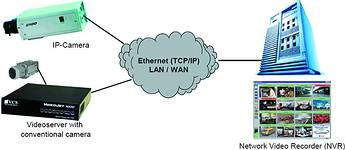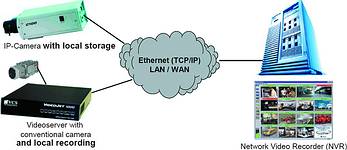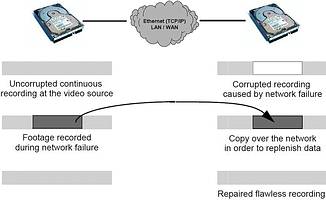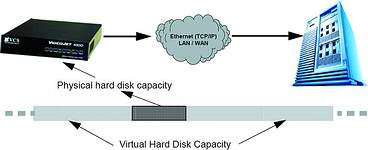
Digital recording technologies have greatly influenced the field of CCTV: no more wear and tear and costly maintenance, no more endless tape rewinding for retrieval.
Digital video recording has brought crisp video images and instantaneous playback of footage, among many other improvements. But is this the end? What will be next in the field of digital video recording for the CCTV industry? This paper introduces future concepts of digital video recording based on information technology (IT) infrastructure, namely networking. We will show that simple network video recording (NVR) does not account for network failures. By employing the introduced principle of 'ANR' (automatic network replenishment) NVR can cope with network downtimes without sacrificing recording integrity. The also introduced concept of 'virtual hard disk' goes one step further and gets rid of the omnipresent question regarding hard disk sizes.
The beginning - from time-lapse to DVRs
Video recording is one of the most important tasks in the field of closed circuit television (CCTV): originally standard VHS type video cassette recorders (VCRs) were used. Using endless tapes in combination with slow recording speeds, up to four to eight hours could be recorded on a single VHS-type cassette. Without changing the tape, the recording would be endlessly overwritten, thereby keeping a history of events for the duration of the tape. Slower recording speeds and the time-lapse mode brought longer coverage per tape.
For longer storage times, tapes have to be changed either manually or by robotic systems. Due to the endless operation and the mechanical nature of the physical recording, tapes and video heads are subject to significant wear, mandating the exchange of tapes and video heads during regular maintenance cycles. For economic reasons, exchange intervals were stretched, sometimes forgotten, resulting in the infamous washed out video recordings, where hardly anything could be recognised.
Also, retrieval is a challenge, with endless type rewindings and with no clues other then the hopefully accurate labelling of the tapes. On the positive side, VHS tapes can be played back on all of the omnipresent VCR decks, and everybody is able to handle it.
DVRs to the rescue
The combination of affordable image compression technology and large capacity hard disks made the development of digital video recorders feasible: video is stored in digitised and compressed form on regular computer hard disks.
Although hard disk recording is also a magnetic recording, in contrast to video tapes, the magnetic heads do not touch the surface of the disks.
Instead the heads are flying at a small distance above the surface, causing no wear to the surfaces. The digital nature of the data ensures that all retrieved footage is an identical copy of the recorded signals.
Another advantage of DVRs is instantaneous retrieval, even while recording is still ongoing. Any part of the recording is available for instantaneous playback without rewinding or any other access time. Additional information like motion activity or meta data may be stored in parallel to the video data itself in order to aid in the retrieval process.
All these advantages have led to a significant growth of DVR technology and an almost complete replacement of analog solutions. In previous years, DVRs came at a premium. Recently, DVRs arrived at the same or even lower cost than older VCRs. DVRs are the technology of choice, especially for small installations.
There are some cons
For larger installations, solutions based on standard DVRs have several disadvantages:
Local video inputs: All video inputs are local to the DVR. Any video source, ie, camera, has to be wired to the location of the DVR(s). Significant investment in cabling is the result.
Analog video-based design: With the future being digital, current DVRs only account for conventional analog CCTV cameras. Current DVRs are unable to work with the growing base of all digital (network) cameras.
Limited capacity design: DVRs are designed for a certain capacity, based on the number of internal hard disks times available and supported hard disk sizes. For larger number of cameras and/or larger recording times, separate DVR units have to be used. Retrieval across distinct units becomes impractical.
Multiplexed operation: Due to the heritage of VCR principles, most DVRs are one-channel designs. In order to accommodate 4, 9,16 or more video inputs, internal or external multiplexers are used. The performance per camera typically drops to a few frames per second.
Non-standard CCTV specific equipment: DVRs are mostly specific designs not taking advantage of common IT-principles like RAID storage or standard, cost efficient IT-equipment.
In order to overcome these drawbacks, network video recording has been developed.
NVR - network video recording
More and more network cameras are being used in today's CCTV applications. Instead of a conventional analog video output, these cameras interface directly to IT-style Ethernet networks. Reasons for the popularity of so-called IP cameras are the availability of the network in most buildings and integrated features like motion detection, scene analysis and alarm features. By employing the network as transmission medium, the cost for dedicated cabling will be saved, compensating for the higher price-tag of today's IP-cameras.
But how do we interface these IP-cameras to DVRs? In most cases, IP cameras cannot be connected to standard DVRs and cannot be mixed with conventional analog cameras. The only way to connect an IP-camera to a standard DVR would be a decoder box, which converts the digital signal back into an analog video signal. This analog signal can be recorded with conventional DVRs, which in turn digitises and compresses the signal. It is easy to grasp that this cascade of coding, decoding and recording will not improve quality and is not very elegant, to say the least.
The solution to the above problem is the so-called 'networked video recording' (NVR) principle: all digital video sources or analog cameras connected to video servers feed their digital data streams into the network.
A computer with sufficient storage capacity serves as the recorder. Driven by a scheduling agent, the NVR accesses the data streams of the remote network cameras and video servers and stores them on hard disk.
An NVR is basically a standard networked PC with a software application that controls the flow of digital video data. Usually a scheduling agent is employed, which controls access to video streams driven by time or activity in the scene. NVRs usually also have mechanisms for retrieval of archived footage and backup capabilities.

NVR technology is a cost efficient and modern way of recording digital video. With IT-concepts such as 'storage area networks (SAN)' or 'network attached storage (NAS)' the capacity can be scaled into the terabyte and even the pentabyte range. Despite these advantages, the weak point is the network: without the network there is no recording!
'ANR' - a concept for coping with network downtime
At the heart of the 'ANR' concept is the capability to account for network downtimes. The cause of the network downtime may be manifold. Examples are:
Equipment failure: Any of the network components may fail, from simple cabling over switches, routers or the storage server itself.
Operator fault: The wrong cables may be pulled during an attempt to reroute wiring or configuration may be changed on error.
Network congestion: Due to heavy traffic network service might become unavailable for video recording.
Step 1: Detection of network status
At the heart of the 'ANR' concept is the detection of network availability. To this end, the video server or the IP-camera on one side and the NVR application on the other side exchange so-called LIVE-CHECK messages.

Whenever the network status changes, ie, the network becomes unavailable and later becomes available again, both the video source and the NVR create an event. This event is logged in the database and may be used to send a message over alternative networks or at a later time, when the network becomes available again.
The Live-Check mechanism effectively ensures that both sender and receiver monitor and keep a log of network availability.
Step 2: Dual recording principle
In order to cope with times when the network is not available, video recording has to take place independently at both sides, namely the sender and the receiver.

To this end, all VCS video servers and IP-cameras are equipped with sender-side recording capabilities. Without actual user interaction, digital video data is streamed through a ring-buffer inside the camera or video server.
Physical implementation of the ring-buffer may vary. Examples are standard hard drives, as depicted above, flash-memories or flash drives, which offer the added benefit of not having any moving parts and therefore are well suited for harsh environments. Even standard volatile memory may be used to buffer video data, however, capacity is usually limited and due to the volatile nature, data is not preserved when power is disconnected.
The capacity of the sender side storage is directly proportional to expected network downtimes plus a safety margin. If, for example, a 1 Mbit/s video data stream, which is recorded on a central NVR, is to be ensured against network downtimes of eight hours, a local storage capacity of app. 3,5 Gbyte is required.
A safety margin is to be added in order to account for delayed detection of network status changes and for clean edit marks inside the video stream.
So in the above example, 4 GB would be the recommended. For reasons explained below, this figure is to be doubled, which brings capacity to around 8 GB, a capacity easily achievable with today's hard disk technology.

It can also be seen that flash memories and even more so standard memory can only serve to bridge short network failure or even only spurious unavailability. Affordable flash memory capacity today is in the order of 32 Mbyte up to 1 Gbyte.
Step 3: Automatic replenishment
The picture below depicts the status of recording at the video source and the NVR after a transient network failure has occurred. The last step in the 'ANR' concepts aims at repairing the corrupted recording at the NVR.

Thanks to the detection of network status changes, both the sender and the NVR know about the gap in the recording at the NVR. When the network becomes available again, an automatic replenishment process is initiated:
The missing data at the NVR side is copied from the intact recording at the sender side, as illustrated by the picture below. In effect, the corrupted recording is seamlessly repaired resulting in a flawless NVR recording despite the network fault.

The reason for doubling the required recording capacity at the sender side, which has been mentioned above, is the time required to copy the missing data from the sender to the NVR. Assuming that the network is capable of the higher rate, it is further assumed that the copy process runs at the same speed as the recording itself, eg, 1 Mbit/s in the above example.
During the copy process of the missing data, recording of the current digital video data has to continue both at the sender and at the NVR side, thereby doubling the data rate on the network for the duration of the replenishment process.
In practice and with today's networks, the copy process will take place at a significant higher speed, eg, 5 Mbit/s, effectively lowering the requirement for buffer capacity at the sender side.
Virtual hard disk
We have already mentioned above that DVR technology is plagued by the limited local capacity of the hard disks used. The number of disks cannot be extended due to physical limitations in the chassis of the DVR. External extensions are usually possible but only push the limit to the next step.
Also, recording on more than a single drive makes retrieval and backup usually very cumbersome. In most cases recording stops when a hard drive fills to capacity and resumes on a second hard disk, effectively causing a gap.
Thanks to the availability of the network interface on VCS products, a concept called 'virtual hard disk' may be realised. The concept is borrowed from today's computer systems, where a virtual memory concept is commonplace.
The idea is that the physically present memory is just a stretch out of a much larger virtual memory, which is held on hard disk. The CPU (central processing unit) is made to believe the larger virtual size, because of a logic unit called 'memory management unit (MMU)', which is responsible for loading and unloading just the section of memory, which the CPU currently needs.
The same concept may be readily employed for digital video recording: the local hard disk inside the video server or the IP-camera is just a segment of a much larger virtual disk. During the process of recording video to the local hard disk, the same amount of data is being copied over the network to a network storage device. Data that has been successfully copied over the network may then be erased from the local hard disk, effectively freeing capacity on the local drive. The net effect is that the local hard disk will never fill up, as long as the network storage device can take the data.

The copy process itself may run continuously at the same speed as the actual video recording or at a much faster speed in bursts. In the latter case, the copying commences as soon as a certain threshold has been reached, eg, half of the local hard disk capacity has been used. According to the FIFO (first in - first out) principle, the oldest data on the local hard disk is backed-up over the network to a network video recorded and deleted locally. The copy process is totally transparent for the video server, who just enjoys a hard disk never filling up.
The virtual hard disk makes the retrieval of recorded video footage especially convenient. Instead of searching over several physical disk volumes, the user always sees a single disk of sufficient capacity.
Have it all
The two concepts introduced above are not mutually exclusive. In fact, it comes quite natural to combine both concepts for added benefit. There are two aspects in the design of the overall system that will ensure the feasibility of the combination of the 'ANR' and the 'virtual hard disk' concept:
Threshold: The trigger point for the start of the backup process should be engineered carefully. An earlier start, eg, less than 50% capacity of the local hard disk has been exhausted, ensures ample capacity for buffering network downtimes. In the worst case scenario, the network becomes unavailable just when the copy process is about to commence.
Data integrity: It has to be carefully checked that the data backed up from the local drive to the network storage server is intact before deleting the local recording portion. Even if the network fails during the copy process, network protocols are designed to cope with that. The available capacity on the local drive should ensure sufficient headroom for buffering.
Conclusion
From the beginnings of tape-based time lapse video recording to today's digital video recording (DVR) has been a vast improvement. With the advent of digital cameras, new recording principles are required which interface to network cameras.
Most of the network video recorders on the market today are not yet ready for professional use, because they totally rely on the availability of the network.
Only if the complete system is capable of handling network downtimes without sacrificing recording coverage and integrity, network video recording is applicable to professional installations.
This paper introduced the concept of 'ANR', which goes beyond network video recording (NVR). A combination of local recording for caching and large background archives serves even the largest installation. The large centralised archive facilitates backup and searching across the complete available footage. The system is error-proof and scales nicely to any size, due to its combination of decentralised security and centralised convenience.
Even smaller installation can benefit from the introduced concepts above.
Hard disk capacity, often seen as the only reference to the capabilities of a DVR, now becomes less meaningful. The concept of 'virtual hard drive' extends the capacity of a physical disk over the network. The least recently recorded data is copied over the network to a centralised background storage device.
Even with small economical physical drives, ring and time-lapse recording times of any size are achievable. To the user, the system is absolutely transparent. One cannot tell whether the recording resides on a single large drive or is spread out over a network.
The paper and the introduced concepts aim to give guidance to users of digital video recording technology. It has been shown that today's DVRs do not represent the end of the technological advancement but rather are the beginning of intelligent recording devices, which are more user friendly and economical.
Dr Michael Gilge, CEO, VCS Video Communication Systems AG, [email protected], www.vcs.com

© Technews Publishing (Pty) Ltd. | All Rights Reserved.